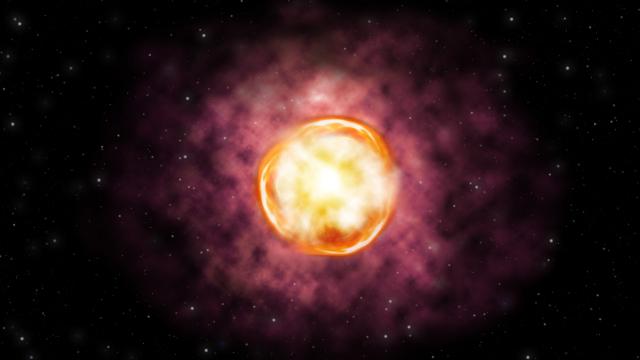Astronomers have observed a supernova unlike any ever observed before, and it might be strong evidence of an important kind of stellar death that would have shaped early galaxies.
The supernova, called SN2016iet, doesn’t fit into the classification schemes that scientists use for supernovae today. It seems to look like a “pair-instability supernova” that would happen among the heaviest stars.
And according to the research team, led by Harvard University graduate student Sebastian Gomez, this could be the most massive star ever observed undergoing a supernova.
“Finding something so distinct from everything we know about is exciting,” Edo Berger, study author and astronomy professor at Harvard University, told Gizmodo.
The Milky Way-mapping Gaia telescope first spotted the flash on 14 November 2016, and it was later re-found by sky-surveying telescopes including the Catalina Real-Time Transient Survey and the Pan-STARRS Survey for Transients. The astronomers continue observing the resulting blip today, including its brightness and the identity of the elements it contained.
How is this supernova different? For one, most supernovae flash once and then fade from astronomers’ view after a few months. But SN2016iet brightened and dimmed twice, and its remnants persist to this day.
Its spectral signature doesn’t contain evidence of hydrogen or helium, which would normally place it into one of the other supernovae categories, but SN2016iet shows abundances of calcium and oxygen not matched in other supernova observations.
Even the place it occurred was weird, far from the centre of a galaxy with an unusually low level of heavier elements.
Three years of observations along with mathematical modelling show that the star could have once been 130 to 260 times the mass of the Sun. It would have shed most of its outer hydrogen and helium over time, becoming a dense core of heavier elements left over from fusion.
If models are correct, then the gamma rays that would normally create outward pressure in the core would instead be absorbed by the neutrons of those heavier elements, and the star would collapse in on itself under the weight of its own gravity. The result would be a nuclear explosion, a process called a pair-instability supernova.
This is the first such pair-instability candidate in which the amount of heavier elements and the inferred mass of the initial star fit within theoretical predictions, according to the paper published in The Astrophysical Journal.
It’s an exciting object, but there’s definitely more to study. “The parameters they need for this scenario, in particular an ejection of material very soon before explosion, are not well explained by current models of this class,” Kate Maguire, assistant professor at Trinity College, Dublin, told Gizmodo in an email.
“The main limitation of the paper is that the theoretical models that have been made to date cannot explain all its properties, and so there is not a clear result on what type of star exploded and how.”
If this supernova really was a pair-instability supernova, that’s exciting, said Berger. “I think that these explosions were probably more common in the early universe,” among the first generation of massive stars. These supernovae could have shaped the way galaxies’ chemical compositions look today. SN2016iet could be a local example of something otherwise limited to the most distant universe.
The physicists will use the Hubble Space Telescope to continue exploring this strange object into 2021.
